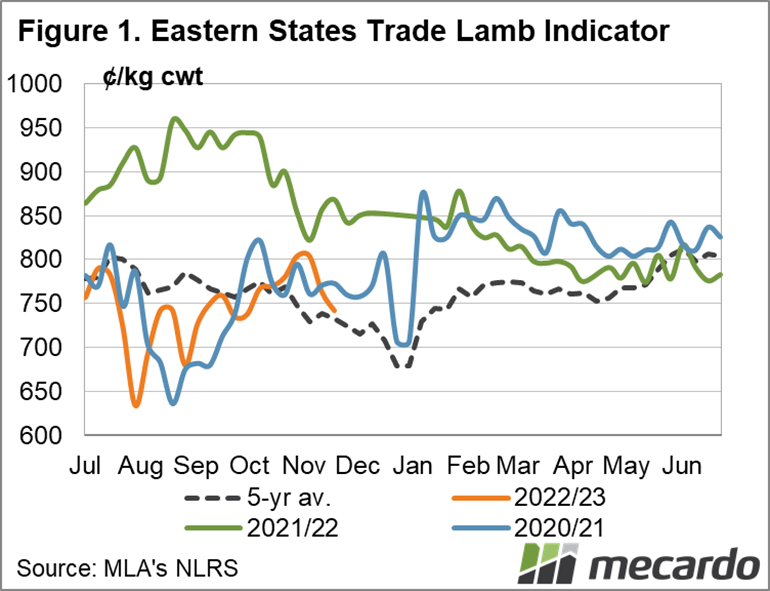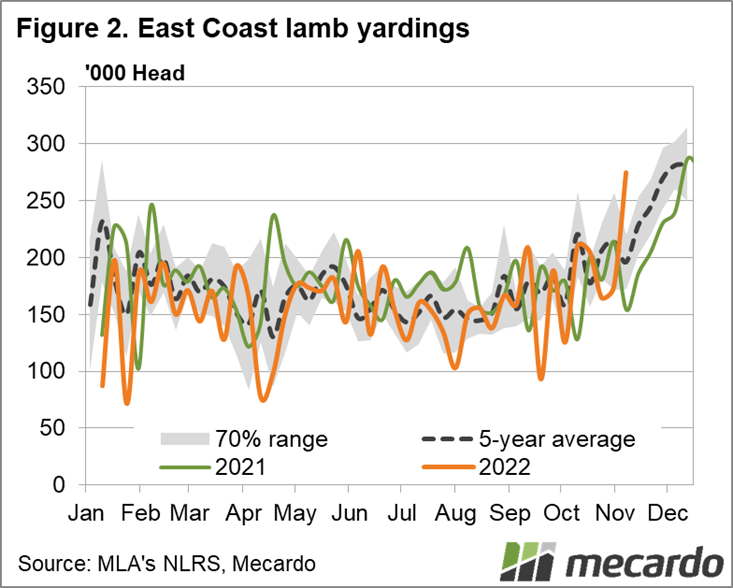The sheep and lamb market has been consistent in one way in the past few months - in that it hasn’t been consistent at all. While the weather always plays a big role in when stock is marketed, it has been the driving force this season, with usual operating procedures having to be deserted by many in NSW and Victoria due to flooding rain. This has caused supply and price volatility week to week, making that sweet spot difficult to pinpoint for those who do have options.
The Eastern States Trade Lamb Indicator averaged 742c/kg last week, a drop of more than 20c/kg on the previous week, nearly 60c/kg below the week before that, and a significant 15% lower than the same time in 2021. That figure climbed back up to 764c/kg on Tuesday, before falling to 753c/kg where it sits now. Let’s note that historically, that is the third highest price on record for that specific week.
If we take a step back from the current yin and yang of the market, predominantly supply driven, with huge offerings followed by constricted ones, we can see the price has been operating at above average levels since mid-October, despite being well below last year’s record highs. The ESTLI did spend most of winter and the start of spring below the five-year average, and from July through to November, the ESTLI has averaged 746c/kg this year. Last year, the same period averaged 902c/kg. The five-year-average for those five months is 767c/kg – 3% higher than 2022 – showing despite recent pick up in returns, it hasn’t yet compensated for earlier lulls.
The ESTLI is tracking similarly to the past two years in that the current price is on-par with the first week of July level. The difference being in both those cases that there was a period of higher returns either in the month prior or the month following which we haven’t experienced this year. On average, the ESTLI lowers slightly from now until the end of the year, before picking up in January-February.
The lateness of the new season lambs coming to market this season – (evident in yarding throughput, which is currently close to 7% below last year for the July-to-now period) (figure 2)- indicates there are still plenty of lambs left to come.
What does it mean?
Access to paddock and transport will continue to heavily impact the ESTLI in the weeks to come, with the ups and downs likely here to stay in the short term. It is unlikely the price is driving supply much at all, with feed, fodder and floods making decisions for lamb producers on much of the east coast from now until Christmas. This should keep the ESTLI in its current range in the short term, but if the expected lambs still to come start entering the market in the new year still at trade weights, that will limit the upside traditionally seen at that time.
Have any questions or comments?
Key Points
- Eastern States Trade Lamb Indicator remains well below year-ago levels, average 15% less last week.
- Current ESTLI still historically very strong, at the third highest level on record for the corresponding week.
- Throughput yet to catch up to last year, indicating supply could put more pressure on returns than normal early in the new year.
Data sources: Mecardo; Meat & Livestock Australia;
Photo Credit: Sarah Parker














